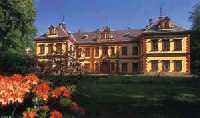Hrabačov, Javorek
Zip code: 514 01
Number of inhabitants: ca. 5900
Elevation: 464 m above the sea level
posta@mesto.jilemnice.cz
www.mestojilemnice.cz
The community is member of union:
The Krkonose Mts. - Union of Municipalities
The town of Jilemnice is situated in a mountainous area of west foothills of the Krkonose Mountains and has about 6 000 inhabitants today. The town has been a very popular as an advantageous setting-off point for the Western Krkonoše for many years, and thus has become their economic and cultural centre.
History:
Jilemnice was established sometimes at the beginning of the 14th century as an economic centre of an extensive Štěpanice estate held by the Valdštejn lineage. The regular ground plan of the town square and of the adjacent streets seems to indicate that the town was probably founded on a green turf. The secluded position protected the town against serious war damage for years, but on the other hand it caused slow development of the town. The development was even more restricted from 1492 when Valdštejns divided the town and the demesne into two individual parts.
We can find first references to Jilemnice mines from the 15th century; in the following century we can locate remarks about a highly developed linen industry. The Thirty Years War’s consequences were disastrous for the town. In 1634 the Swedes burnt the town and it was impoverished to such an extent that the construction of a small wooden school in 1638 and again in 1683 required the co-operation of both parts of then divided municipality and the sale of certain parts of the municipal property. The trade was weakened during the whole 17th century and the attempts to restore the local mining of ore were unsuccessful.
A sweeping turn for the better did not come until the year 1701, when both parts of the demesne were reunited together again with the town in the hands of one owner, the count’s dynasty of Harrachs, whose members were known for their flexible and progressive economic policy. At first the new owners lifted the local glass and linen industries to the world level. They imported linseeds of greater quality from abroad and simultaneously invited experienced foreign specialists to teach the locals better techniques for linen processing. The Harrachs founded a number of bleaching plants, which supplied waste successfully used in agriculture as the first artificial fertilizer. The linen manufacturing in Jilemnice achieved its highest recognition in the second half of the 18th century and at the beginning of the 19th century, when superb batiste, veils and other goods of the highest quality had been woven here. The acquired fame of the local goods stretched far beyond the border of the Austrian monarchy. The town grew rich by the linen industry. The affluence of the town can be seen up to now in a number of pieces of architecture and the valuable equipment of the St. Vavřinec church. But the enhanced building activity was accompanied by pernicious fires especially in 1788, 1803 and 1838.
During the first half of the 19th century the linen industry was slowly declining. The textile business was increasingly under the control of a modern large-scale factory production, in which Jilemnice was unable to win a greater recognition. Only in the second half of the century the business in the town started to increase.In the year 1892 count Jan Harrach brought the first skis to the Krkonoše Mountains for his forest workers. Jilemnice has developed into the most important Czech skiing centre, for sure rightly called “the cradle of the Czech skiing”. In 1894 the local skiers founded the first independent ski club in the Czech countries and Slovakia “The Czech Krkonoše Club SKI”. The promising development of the town continued even in the period between the two world wars. It was only slowed down by the consequences of Mnichov agreement, which moved the state border to the close proximity of the town, and was the reason for stagnating economic links and also affected the tourism.
After 1945 the town went through notable changes. Textile factories were partly replaced by an engineering industry and a food industry (Cutisin a. s., the only manufacturer of artificial casings in the Czech Republic).









